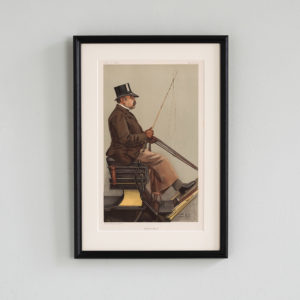821 items found
Page 6 of 9
-
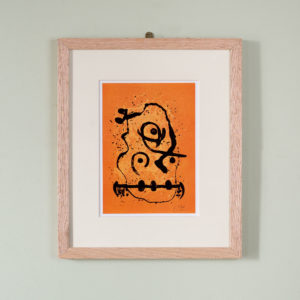
Joan Miró, lithographs
£180Joan Miró, lithographs
In 1967, printer Robert Dutrou introduced Joan Miró to a new printmaking technique: Silicon carbide engraving. More commonly known as carborundum, this technique became the artist’s final technical development in his graphic work.£180 -
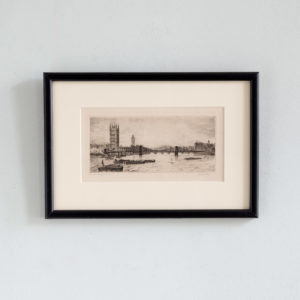
Lambeth Bridge, by J. H. Wiley
£180 -
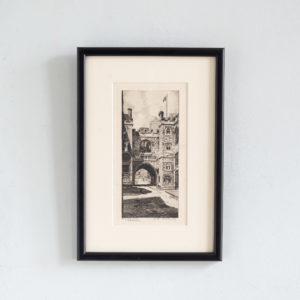
St John Gate, Clerkenwell, by J. H. Wiley
£180 -
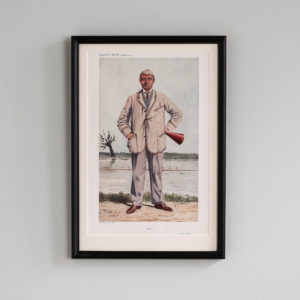
Bill,
£180Bill,
A framed chromolithograph by ELF picturing Robert Henry Foster, lawyer, author, poet, oarsmen and pioneering Romano-British archaeologist. His excavations at Roman Corbridge on Hadrian's Wall were seminal in the fledgling field of British archaeology. He wrote widely about Hadrian's Wall and the Roman presence in his native Northumberland. A keen oarsman, he rowed in the first boat of his college's Lady Margaret Boat Club and in the crew sent to Henley in 1888, winning both the Thames cup and Ladies plate. He later became joint secretary of the Thames Rowing Club in 1892. Starting out with a legal career in mind, he was called to the Bar in 1892, having been McMahon Law Student the year before. However, his writing soon took precedence, to be joined by his archaeological interests.£180 -
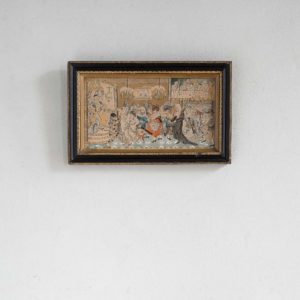
The Ball,
£180 -
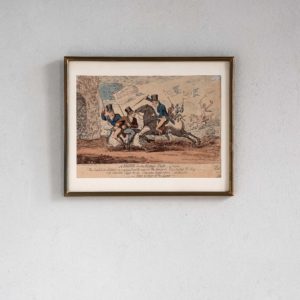
A Match for the King’s Plate,
£180A Match for the King’s Plate,
A hand coloured etching by George Cruikshank commenting on the contest for seat of Westminster. George Lamb and John Cam Hobhouse, 1st Baron Broughton are shown astride a lamb, Sir Francis Burdett, 5th Baronet, on a fine but injured charger and Henry 'Orator' Hunt straggles behind on an old carthorse representing the 'Father of Reform' Major John Cartwright. All five figures are shown racing for the winning post at the gate of His Majesty's Treasury with an implication that the contest is for one for both power and political patronage while the twin devils or radical reform and universal suffrage inadvertently 'steal a ride' on the Baronet's charger. The election of 1818 was the first to be staged after the end of the Napoleonic wars and was to become both a distillation of the latent class-conflicts bubbling over in the United Kingdom, and a fore-warning of the growth of militant radicalism that was to envenom and fracture British politics in the early parts of the 19th Century. Sir Francis Burdett was the Radical incumbent in Westminster and yet was firmly set against the new Radicalism which was beginning to colour the politics of the manufacturing districts of the North. This extreme and confident movement for universal manhood suffrage and political reform was by now associated with Henry Hunt, Major Cartwright and the writer and journalist William Cobbett. Caught in a cleft stick by his need both to mollify the prosperous and respectable Westminster electorate and yet maintain his own character as a tribune of the plebeians and Radical leader, Burdett was in a classic political double-bind. To the eye of the exiled Cobbett the Baronet was a placeman and an establishment 'traitor' but to his Tory opponents and the wavering freeholders and burgesses of Westminster he was beginning to appear a dangerous extremist. The suicide of Sir Samuel Romilly, the second member for Westminster, in November 1818 threw the situation wide open and the resulting by-election became something of a national sensation.£180 -
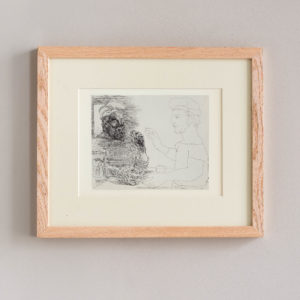
Picasso, Vollard Suite, 1956. c. May 1933.
£175 eachPicasso, Vollard Suite, 1956. c. May 1933.
Lithographs, published 1956 based on Picasso's work, produced from 1930-1937 for the art dealer Ambroise Vollard. Framed in plain oak with cream mounts. c. May 1933. Two Catalan Men£175 each -
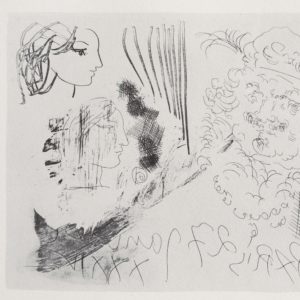
Picasso, Vollard Suite, 1956. Paris, January 27, 1934.
£175 eachPicasso, Vollard Suite, 1956. Paris, January 27, 1934.
Lithographs, published 1956 based on Picasso's work, produced from 1930-1937 for the art dealer Ambroise Vollard. Framed in plain oak with cream mounts. Paris, January 27, 1934. Head of Rembrandt and Heads of Three Girls£175 each -
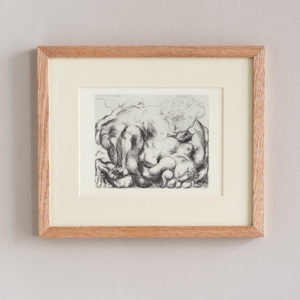
Picasso, Vollard Suite, 1956. Boisgeloup, April 23, 1933.
£175 eachPicasso, Vollard Suite, 1956. Boisgeloup, April 23, 1933.
Lithographs, published 1956 based on Picasso's work, produced from 1930-1937 for the art dealer Ambroise Vollard. Framed in plain oak with cream mounts. Boisgeloup, April 23, 1933. Embrace£175 each -
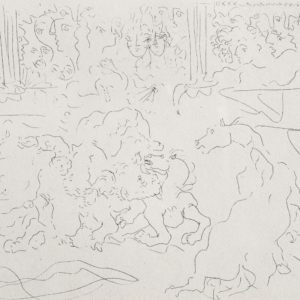
Picasso, Vollard Suite, 1956. Paris, November 7, 1933.
£175 eachPicasso, Vollard Suite, 1956. Paris, November 7, 1933.
Lithographs, published 1956 based on Picasso's work, produced from 1930-1937 for the art dealer Ambroise Vollard. Framed in plain oak with cream mounts. Paris, November 7, 1933. Bullfight I£175 each -
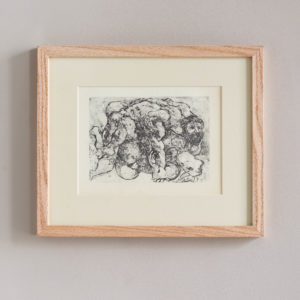
Picasso, Vollard Suite, 1956. Paris, November 2, 1933.
£175 eachPicasso, Vollard Suite, 1956. Paris, November 2, 1933.
Lithographs, published 1956 based on Picasso's work, produced from 1930-1937 for the art dealer Ambroise Vollard. Framed in plain oak with cream mounts. Paris, November 2, 1933. Embrace£175 each -
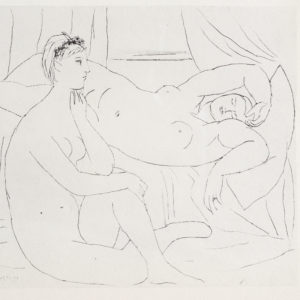
Picasso, Vollard Suite, 1956.
£175 eachPicasso, Vollard Suite, 1956.
Lithographs, published 1956 based on Picasso's work, produced from 1930-1937 for the art dealer Ambroise Vollard. Framed in plain oak with cream mounts. 1931. Two Nudes Resting.£175 each -

Picasso, Vollard Suite, 1956. Paris, May 5, 1933.
£175 eachPicasso, Vollard Suite, 1956. Paris, May 5, 1933.
Lithographs, published 1956 based on Picasso's work, produced from 1930-1937 for the art dealer Ambroise Vollard. Framed in plain oak with cream mounts. Paris, May 5, 1933. Sculpture of Seated Nude, Sculptured Head, and Vase of Flowers.£175 each -
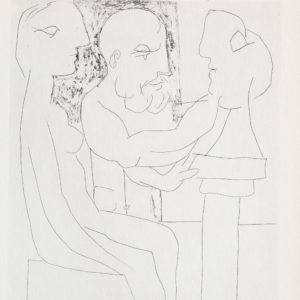
Picasso, Vollard Suite, 1956. Paris, March 25, 1933,
£175 eachPicasso, Vollard Suite, 1956. Paris, March 25, 1933,
Lithographs, published 1956 based on Picasso's work, produced from 1930-1937 for the art dealer Ambroise Vollard. Framed in plain oak with cream mounts. Paris, March 25, 1933. Sculptor Working from a Model.£175 each -
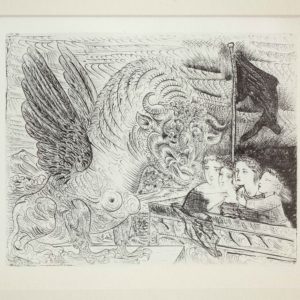
Picasso, Vollard Suite, 1956. c. May 1933.
£175 eachPicasso, Vollard Suite, 1956. c. May 1933.
Lithographs, published 1956 based on Picasso's work, produced from 1930-1937 for the art dealer Ambroise Vollard. Framed in plain oak with cream mounts. c. May 1933. Four Children Viewing a Monster.£175 each -
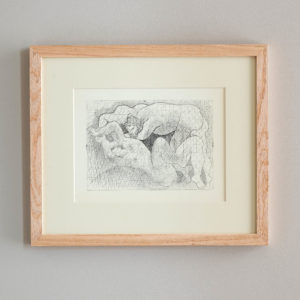
Picasso, Vollard Suite, 1956.
£175 eachPicasso, Vollard Suite, 1956.
Lithographs, published 1956 based on Picasso's work, produced from 1930-1937 for the art dealer Ambroise Vollard. Framed in plain oak with cream mounts. 1931. The Rape£175 each -
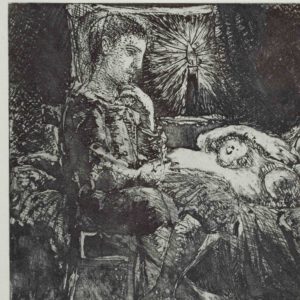
Picasso, Vollard Suite, 1956. c. 1935.
£175 eachPicasso, Vollard Suite, 1956. c. 1935.
Lithographs, published 1956 based on Picasso's work, produced from 1930-1937 for the art dealer Ambroise Vollard. Framed in plain oak with cream mounts. c. 1935. Boy Watching over Sleeping Woman by Candlelight.£175 each -
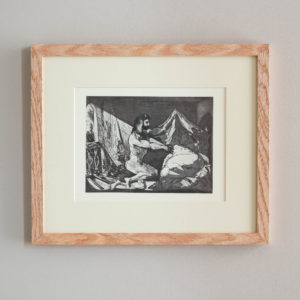
Picasso, Vollard Suite, 1956. June 12, 1936.
£175 eachPicasso, Vollard Suite, 1956. June 12, 1936.
Lithographs, published 1956 based on Picasso's work, produced from 1930-1937 for the art dealer Ambroise Vollard. Framed in plain oak with cream mounts. June 12, 1936. Satyr and Sleeping Woman.£175 each -
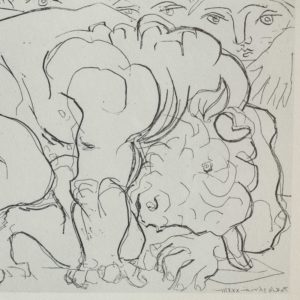
Picasso, Vollard Suite, 1956. Paris, May 26, 1933.
£175 eachPicasso, Vollard Suite, 1956. Paris, May 26, 1933.
Lithographs, published 1956 based on Picasso's work, produced from 1930-1937 for the art dealer Ambroise Vollard. Framed in plain oak with cream mounts. Paris, May 26, 1933. Dying Minotaur.£175 each -
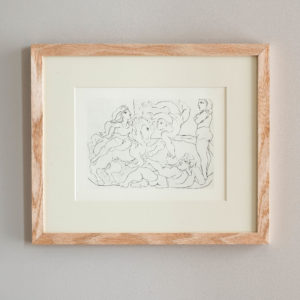
Picasso, Vollard Suite, 1956. Paris, November 11, 1933.
£175 eachPicasso, Vollard Suite, 1956. Paris, November 11, 1933.
Lithographs, published 1956 based on Picasso's work, produced from 1930-1937 for the art dealer Ambroise Vollard. Framed in plain oak with cream mounts. Paris, November 11, 1933. Acrobats with a Horse.£175 each -
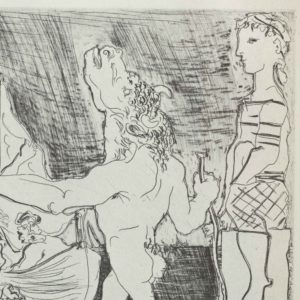
Picasso, Vollard Suite, 1956. Paris, October 23, 1934.
£175 eachPicasso, Vollard Suite, 1956. Paris, October 23, 1934.
Lithographs, published 1956 based on Picasso's work, produced from 1930-1937 for the art dealer Ambroise Vollard. Framed in plain oak with cream mounts. Paris, October 23, 1934. Blind Minotaur Led through the Night by Girl with Dove.£175 each -
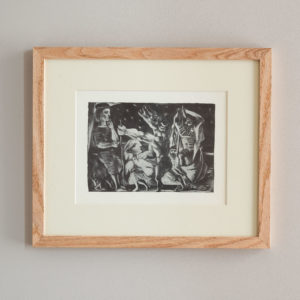
Picasso, Vollard Suite, 1956. c. 1935.
£175 eachPicasso, Vollard Suite, 1956. c. 1935.
Lithographs, published 1956 based on Picasso's work, produced from 1930-1937 for the art dealer Ambroise Vollard. Framed in plain oak with cream mounts. c, 1935. Blind Minotaur Led through the Night by Girl with Fluttering Dove.£175 each -

Picasso, Vollard Suite, 1956. Paris, June 16, 1933
£175 eachPicasso, Vollard Suite, 1956. Paris, June 16, 1933
Lithographs, published 1956 based on Picasso's work, produced from 1930-1937 for the art dealer Ambroise Vollard. Framed in plain oak with cream mounts. Paris, June 16, 1933. Minotaur with Girl in His Arms£175 each -
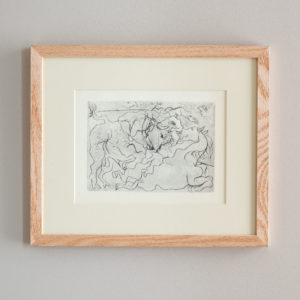
Picasso, Vollard Suite, 1956. Paris, November 8, 1933.
£175 eachPicasso, Vollard Suite, 1956. Paris, November 8, 1933.
Lithographs, published 1956 based on Picasso's work, produced from 1930-1937 for the art dealer Ambroise Vollard. Framed in plain oak with cream mounts. Paris, November 8, 1933. Bullfight II£175 each -
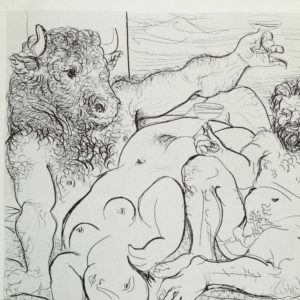
Picasso, Vollard Suite, 1956. Paris, May 18, 1933.
£175 eachPicasso, Vollard Suite, 1956. Paris, May 18, 1933.
Lithographs, published 1956 based on Picasso's work, produced from 1930-1937 for the art dealer Ambroise Vollard. Framed in plain oak with cream mounts. Paris, May 18, 1933. Drinking Minotaur and Sculptor with Two Models£175 each -
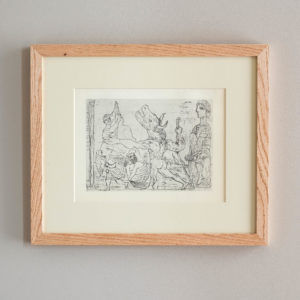
Picasso, Vollard Suite, 1956. c. October 1934.
£175 eachPicasso, Vollard Suite, 1956. c. October 1934.
Lithographs, published 1956 based on Picasso's work, produced from 1930-1937 for the art dealer Ambroise Vollard. Framed in plain oak with cream mounts. c. October 1934. Blind Minotaur Led by Girl with Fluttering Dove.£175 each -
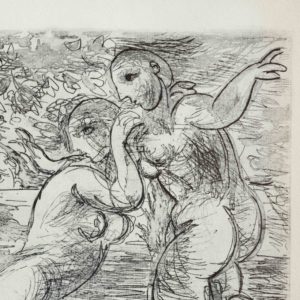
Picasso, Vollard Suite, 1956. Paris, May 22, 1933.
£175 eachPicasso, Vollard Suite, 1956. Paris, May 22, 1933.
Lithographs, published 1956 based on Picasso's work, produced from 1930-1937 for the art dealer Ambroise Vollard. Framed in plain oak with cream mounts. Paris, May 22, 1933. Two Nudes Bathing. At left, Sculptured Head and Head of Spectator.£175 each -
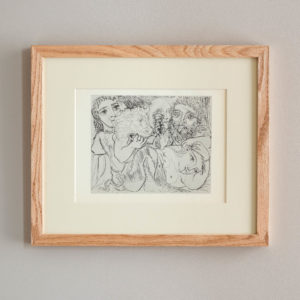
Picasso, Vollard Suite, 1956. Boisgeloup, June 18, 1933.
£175 eachPicasso, Vollard Suite, 1956. Boisgeloup, June 18, 1933.
Lithographs, published 1956 based on Picasso's work, produced from 1930-1937 for the art dealer Ambroise Vollard. Framed in plain oak with cream mounts. Boisgeloup, June 18, 1933. Minotaur, Drinking Sculptor, and Three Models.£175 each -

Picasso, Vollard Suite, 1956. Boisgeloup, June 18, 1933.
£175 eachPicasso, Vollard Suite, 1956. Boisgeloup, June 18, 1933.
Lithographs, published 1956 based on Picasso's work, produced from 1930-1937 for the art dealer Ambroise Vollard. Framed in plain oak with cream mounts. Boisgeloup, June 18, 1933. Minotaur over Sleeping Girl.£175 each -
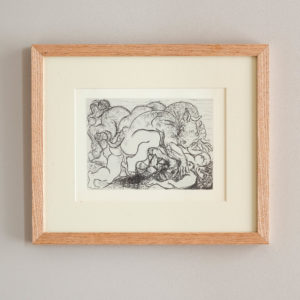
Picasso, Vollard Suite, 1956. Paris, May 23, 1933.
£175 eachPicasso, Vollard Suite, 1956. Paris, May 23, 1933.
Lithographs, published 1956 based on Picasso's work, produced from 1930-1937 for the art dealer Ambroise Vollard. Framed in plain oak with cream mounts. Paris, May 23, 1933. Minotaur Assaulting a Girl.£175 each -
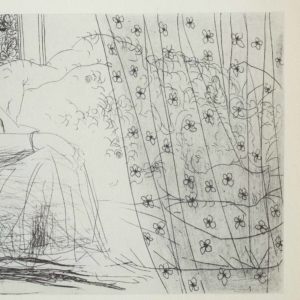
Picasso, Vollard Suite, 1956. Paris, May 18, 1933.
£175 eachPicasso, Vollard Suite, 1956. Paris, May 18, 1933.
Lithographs, published 1956 based on Picasso's work, produced from 1930-1937 for the art dealer Ambroise Vollard. Framed in plain oak with cream mounts. Paris, May 18, 1933. Girl Seated by Sleeping Minotaur.£175 each -
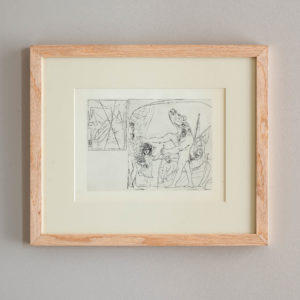
Picasso, Vollard Suite, 1956. Boisgeloup. September 22, 1934.
£175 eachPicasso, Vollard Suite, 1956. Boisgeloup. September 22, 1934.
Lithographs, published 1956 based on Picasso's work, produced from 1930-1937 for the art dealer Ambroise Vollard. Framed in plain oak with cream mounts. Boisegeloup. September 22, 1934. Blind Minotaur Led by Girl with Bouquet of Wild Flowers.£175 each -

Picasso, Vollard Suite, 1956. Paris, March 10, 1934
£175 eachPicasso, Vollard Suite, 1956. Paris, March 10, 1934
Lithographs, published 1956 based on Picasso's work, produced from 1930-1937 for the art dealer Ambroise Vollard. Framed in plain oak with cream mounts. Paris, March 10, 1934. Four Models and a Sculptured Head.£175 each -
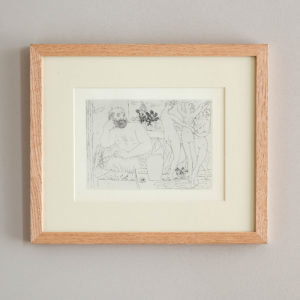
Picasso, Vollard Suite, 1956. Paris, March 2, 1934
£175 eachPicasso, Vollard Suite, 1956. Paris, March 2, 1934
Lithographs, published 1956 based on Picasso's work, produced from 1930-1937 for the art dealer Ambroise Vollard. Framed in plain oak with cream mounts. Paris, March 2, 1934. Sculptor and Statue of Three Female Dancers£175 each -
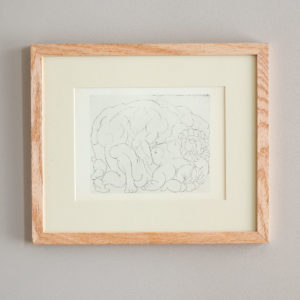
Picasso, Vollard Suite, 1956. Boisgeloup, April 22, 1933.
£175 eachPicasso, Vollard Suite, 1956. Boisgeloup, April 22, 1933.
Lithographs, published 1956 based on Picasso's work, produced from 1930-1937 for the art dealer Ambroise Vollard. Framed in plain oak with cream mounts. Boisegeloup, April 22, 1933. Embrace.£175 each -
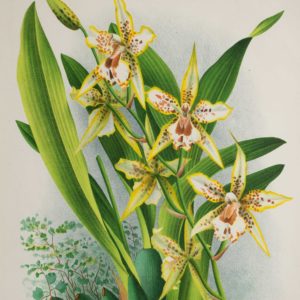
Linden Botanicals, Odontoglossum Duvivieranum,
£175 eachLinden Botanicals, Odontoglossum Duvivieranum,
L’Illustration Horticole, was a monthly horticultural review, founded in 1854 in Ghent, Belgium, by Ambroise Verschaffelt, a nurseryman who specialised in new plant introductions from South America. The lavish illustrations were produced by some of the very best botanical artists and lithographers – A. Goosens, P. De Pannemaeker and J. Goffart. The L’Illustration Horticole although founded by Jean Jules Linden (1817 – 1898) became a collaborative effort of many great horticulturists and field botanists of the day. Jean Linden in his own right was a renowned orchid grower and collector. Each monthly edition featured chromolithograph of botanical prints. Plants such as orchids, camellias, roses and leafy plants such as ferns and palm trees were represented. The magazine’s scope included pictures, descriptions, the history and culture of “the most remarkable plants,” new introductions, horticultural history, botanical expeditions, and accounts of the major expositions and of new works on botany and horticulture as well as garden descriptions and layouts.£175 each -
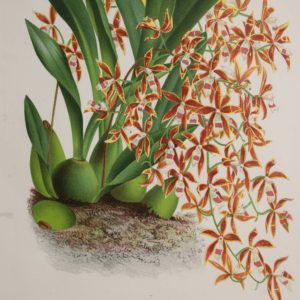
Linden Botanicals, Odontoglossum Constricutum,
£175 eachLinden Botanicals, Odontoglossum Constricutum,
L’Illustration Horticole, was a monthly horticultural review, founded in 1854 in Ghent, Belgium, by Ambroise Verschaffelt, a nurseryman who specialised in new plant introductions from South America. The lavish illustrations were produced by some of the very best botanical artists and lithographers – A. Goosens, P. De Pannemaeker and J. Goffart. The L’Illustration Horticole although founded by Jean Jules Linden (1817 – 1898) became a collaborative effort of many great horticulturists and field botanists of the day. Jean Linden in his own right was a renowned orchid grower and collector. Each monthly edition featured chromolithograph of botanical prints. Plants such as orchids, camellias, roses and leafy plants such as ferns and palm trees were represented. The magazine’s scope included pictures, descriptions, the history and culture of “the most remarkable plants,” new introductions, horticultural history, botanical expeditions, and accounts of the major expositions and of new works on botany and horticulture as well as garden descriptions and layouts.£175 each -
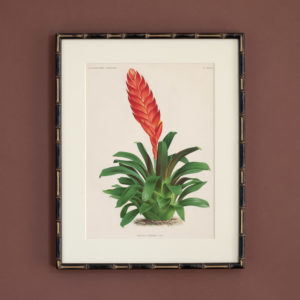
Linden Botanicals, Vriesea Fulgida,
£175 eachLinden Botanicals, Vriesea Fulgida,
L’Illustration Horticole, was a monthly horticultural review, founded in 1854 in Ghent, Belgium, by Ambroise Verschaffelt, a nurseryman who specialised in new plant introductions from South America. The lavish illustrations were produced by some of the very best botanical artists and lithographers – A. Goosens, P. De Pannemaeker and J. Goffart. The L’Illustration Horticole although founded by Jean Jules Linden (1817 – 1898) became a collaborative effort of many great horticulturists and field botanists of the day. Jean Linden in his own right was a renowned orchid grower and collector. Each monthly edition featured chromolithograph of botanical prints. Plants such as orchids, camellias, roses and leafy plants such as ferns and palm trees were represented. The magazine’s scope included pictures, descriptions, the history and culture of “the most remarkable plants,” new introductions, horticultural history, botanical expeditions, and accounts of the major expositions and of new works on botany and horticulture as well as garden descriptions and layouts.£175 each -
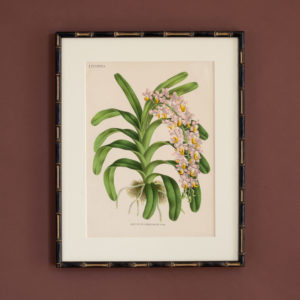
Linden Botanicals, Aerides Reichenbachi,
£175 eachLinden Botanicals, Aerides Reichenbachi,
L’Illustration Horticole, was a monthly horticultural review, founded in 1854 in Ghent, Belgium, by Ambroise Verschaffelt, a nurseryman who specialised in new plant introductions from South America. The lavish illustrations were produced by some of the very best botanical artists and lithographers – A. Goosens, P. De Pannemaeker and J. Goffart. The L’Illustration Horticole although founded by Jean Jules Linden (1817 – 1898) became a collaborative effort of many great horticulturists and field botanists of the day. Jean Linden in his own right was a renowned orchid grower and collector. Each monthly edition featured chromolithograph of botanical prints. Plants such as orchids, camellias, roses and leafy plants such as ferns and palm trees were represented. The magazine’s scope included pictures, descriptions, the history and culture of “the most remarkable plants,” new introductions, horticultural history, botanical expeditions, and accounts of the major expositions and of new works on botany and horticulture as well as garden descriptions and layouts.£175 each -
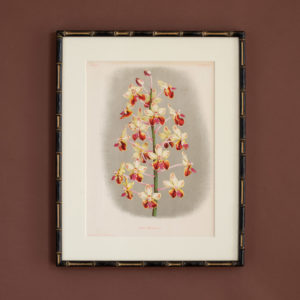
Linden Botanicals, Vanda Superba,
£175 eachLinden Botanicals, Vanda Superba,
L’Illustration Horticole, was a monthly horticultural review, founded in 1854 in Ghent, Belgium, by Ambroise Verschaffelt, a nurseryman who specialised in new plant introductions from South America. The lavish illustrations were produced by some of the very best botanical artists and lithographers – A. Goosens, P. De Pannemaeker and J. Goffart. The L’Illustration Horticole although founded by Jean Jules Linden (1817 – 1898) became a collaborative effort of many great horticulturists and field botanists of the day. Jean Linden in his own right was a renowned orchid grower and collector. Each monthly edition featured chromolithograph of botanical prints. Plants such as orchids, camellias, roses and leafy plants such as ferns and palm trees were represented. The magazine’s scope included pictures, descriptions, the history and culture of “the most remarkable plants,” new introductions, horticultural history, botanical expeditions, and accounts of the major expositions and of new works on botany and horticulture as well as garden descriptions and layouts.£175 each -
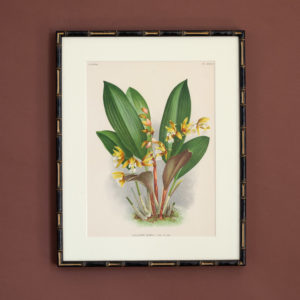
Linden Botanicals, Coelogyne Lurida,
£175 eachLinden Botanicals, Coelogyne Lurida,
L’Illustration Horticole, was a monthly horticultural review, founded in 1854 in Ghent, Belgium, by Ambroise Verschaffelt, a nurseryman who specialised in new plant introductions from South America. The lavish illustrations were produced by some of the very best botanical artists and lithographers – A. Goosens, P. De Pannemaeker and J. Goffart. The L’Illustration Horticole although founded by Jean Jules Linden (1817 – 1898) became a collaborative effort of many great horticulturists and field botanists of the day. Jean Linden in his own right was a renowned orchid grower and collector. Each monthly edition featured chromolithograph of botanical prints. Plants such as orchids, camellias, roses and leafy plants such as ferns and palm trees were represented. The magazine’s scope included pictures, descriptions, the history and culture of “the most remarkable plants,” new introductions, horticultural history, botanical expeditions, and accounts of the major expositions and of new works on botany and horticulture as well as garden descriptions and layouts.£175 each -
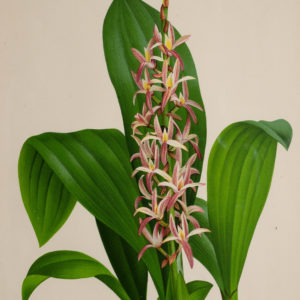
Linden Botanicals, Eria Striolata,
£175 eachLinden Botanicals, Eria Striolata,
L’Illustration Horticole, was a monthly horticultural review, founded in 1854 in Ghent, Belgium, by Ambroise Verschaffelt, a nurseryman who specialised in new plant introductions from South America. The lavish illustrations were produced by some of the very best botanical artists and lithographers – A. Goosens, P. De Pannemaeker and J. Goffart. The L’Illustration Horticole although founded by Jean Jules Linden (1817 – 1898) became a collaborative effort of many great horticulturists and field botanists of the day. Jean Linden in his own right was a renowned orchid grower and collector. Each monthly edition featured chromolithograph of botanical prints. Plants such as orchids, camellias, roses and leafy plants such as ferns and palm trees were represented. The magazine’s scope included pictures, descriptions, the history and culture of “the most remarkable plants,” new introductions, horticultural history, botanical expeditions, and accounts of the major expositions and of new works on botany and horticulture as well as garden descriptions and layouts.£175 each -
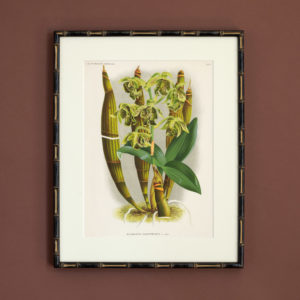
Linden Botanicals, Dendiobium Macrophyllum,
£175 eachLinden Botanicals, Dendiobium Macrophyllum,
L’Illustration Horticole, was a monthly horticultural review, founded in 1854 in Ghent, Belgium, by Ambroise Verschaffelt, a nurseryman who specialised in new plant introductions from South America. The lavish illustrations were produced by some of the very best botanical artists and lithographers – A. Goosens, P. De Pannemaeker and J. Goffart. The L’Illustration Horticole although founded by Jean Jules Linden (1817 – 1898) became a collaborative effort of many great horticulturists and field botanists of the day. Jean Linden in his own right was a renowned orchid grower and collector. Each monthly edition featured chromolithograph of botanical prints. Plants such as orchids, camellias, roses and leafy plants such as ferns and palm trees were represented. The magazine’s scope included pictures, descriptions, the history and culture of “the most remarkable plants,” new introductions, horticultural history, botanical expeditions, and accounts of the major expositions and of new works on botany and horticulture as well as garden descriptions and layouts.£175 each -
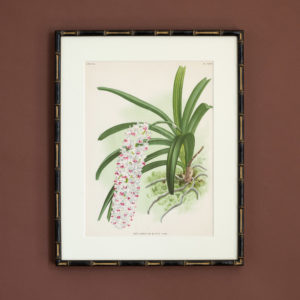
Linden Botanicals, Rhynchostylis Retusa,
£175 eachLinden Botanicals, Rhynchostylis Retusa,
L’Illustration Horticole, was a monthly horticultural review, founded in 1854 in Ghent, Belgium, by Ambroise Verschaffelt, a nurseryman who specialised in new plant introductions from South America. The lavish illustrations were produced by some of the very best botanical artists and lithographers – A. Goosens, P. De Pannemaeker and J. Goffart. The L’Illustration Horticole although founded by Jean Jules Linden (1817 – 1898) became a collaborative effort of many great horticulturists and field botanists of the day. Jean Linden in his own right was a renowned orchid grower and collector. Each monthly edition featured chromolithograph of botanical prints. Plants such as orchids, camellias, roses and leafy plants such as ferns and palm trees were represented. The magazine’s scope included pictures, descriptions, the history and culture of “the most remarkable plants,” new introductions, horticultural history, botanical expeditions, and accounts of the major expositions and of new works on botany and horticulture as well as garden descriptions and layouts.£175 each -
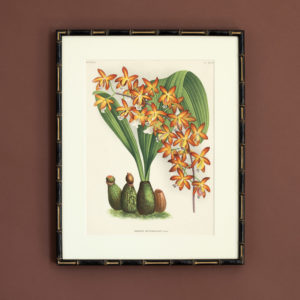
Linden Botanicals, Eriopsis Rutidobulbon,
£175 eachLinden Botanicals, Eriopsis Rutidobulbon,
L’Illustration Horticole, was a monthly horticultural review, founded in 1854 in Ghent, Belgium, by Ambroise Verschaffelt, a nurseryman who specialised in new plant introductions from South America. The lavish illustrations were produced by some of the very best botanical artists and lithographers – A. Goosens, P. De Pannemaeker and J. Goffart. The L’Illustration Horticole although founded by Jean Jules Linden (1817 – 1898) became a collaborative effort of many great horticulturists and field botanists of the day. Jean Linden in his own right was a renowned orchid grower and collector. Each monthly edition featured chromolithograph of botanical prints. Plants such as orchids, camellias, roses and leafy plants such as ferns and palm trees were represented. The magazine’s scope included pictures, descriptions, the history and culture of “the most remarkable plants,” new introductions, horticultural history, botanical expeditions, and accounts of the major expositions and of new works on botany and horticulture as well as garden descriptions and layouts.£175 each -
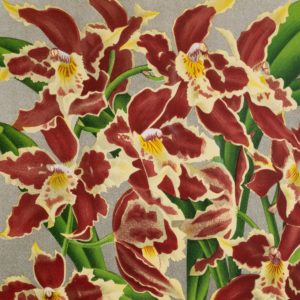
Linden Botanicals, Odontoglossum Crispum,
£175 eachLinden Botanicals, Odontoglossum Crispum,
L’Illustration Horticole, was a monthly horticultural review, founded in 1854 in Ghent, Belgium, by Ambroise Verschaffelt, a nurseryman who specialised in new plant introductions from South America. The lavish illustrations were produced by some of the very best botanical artists and lithographers – A. Goosens, P. De Pannemaeker and J. Goffart. The L’Illustration Horticole although founded by Jean Jules Linden (1817 – 1898) became a collaborative effort of many great horticulturists and field botanists of the day. Jean Linden in his own right was a renowned orchid grower and collector. Each monthly edition featured chromolithograph of botanical prints. Plants such as orchids, camellias, roses and leafy plants such as ferns and palm trees were represented. The magazine’s scope included pictures, descriptions, the history and culture of “the most remarkable plants,” new introductions, horticultural history, botanical expeditions, and accounts of the major expositions and of new works on botany and horticulture as well as garden descriptions and layouts.£175 each -
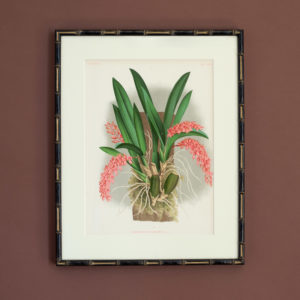
Linden Botanicals, Rodriguezia Bungerothi,
£175 eachLinden Botanicals, Rodriguezia Bungerothi,
L’Illustration Horticole, was a monthly horticultural review, founded in 1854 in Ghent, Belgium, by Ambroise Verschaffelt, a nurseryman who specialised in new plant introductions from South America. The lavish illustrations were produced by some of the very best botanical artists and lithographers – A. Goosens, P. De Pannemaeker and J. Goffart. The L’Illustration Horticole although founded by Jean Jules Linden (1817 – 1898) became a collaborative effort of many great horticulturists and field botanists of the day. Jean Linden in his own right was a renowned orchid grower and collector. Each monthly edition featured chromolithograph of botanical prints. Plants such as orchids, camellias, roses and leafy plants such as ferns and palm trees were represented. The magazine’s scope included pictures, descriptions, the history and culture of “the most remarkable plants,” new introductions, horticultural history, botanical expeditions, and accounts of the major expositions and of new works on botany and horticulture as well as garden descriptions and layouts.£175 each -
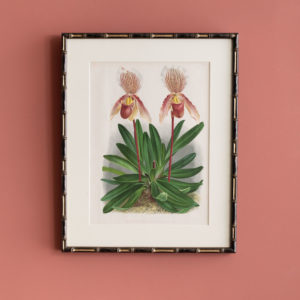
Linden Botanicals,
£175 eachLinden Botanicals,
L’Illustration Horticole, was a monthly horticultural review, founded in 1854 in Ghent, Belgium, by Ambroise Verschaffelt, a nurseryman who specialised in new plant introductions from South America. The lavish illustrations were produced by some of the very best botanical artists and lithographers – A. Goosens, P. De Pannemaeker and J. Goffart. The L’Illustration Horticole although founded by Jean Jules Linden (1817 – 1898) became a collaborative effort of many great horticulturists and field botanists of the day. Jean Linden in his own right was a renowned orchid grower and collector. Each monthly edition featured chromolithograph of botanical prints. Plants such as orchids, camellias, roses and leafy plants such as ferns and palm trees were represented. The magazine’s scope included pictures, descriptions, the history and culture of “the most remarkable plants,” new introductions, horticultural history, botanical expeditions, and accounts of the major expositions and of new works on botany and horticulture as well as garden descriptions and layouts.£175 each -
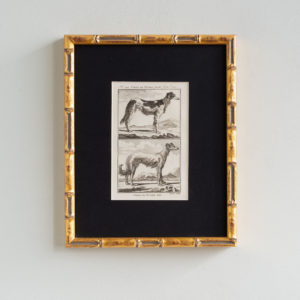
18th Century French Engravings of Dogs
£175 each18th Century French Engravings of Dogs
Published for, Histoire naturelle, générale et particulière (1749–1804), which was the first modern attempt to systematically present all existing knowledge in the fields of natural history, geology, and anthropology.£175 each -
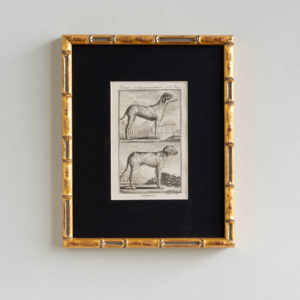
18th Century French Engravings of Dogs
£175 each18th Century French Engravings of Dogs
Published for, Histoire naturelle, générale et particulière (1749–1804), which was the first modern attempt to systematically present all existing knowledge in the fields of natural history, geology, and anthropology.£175 each -
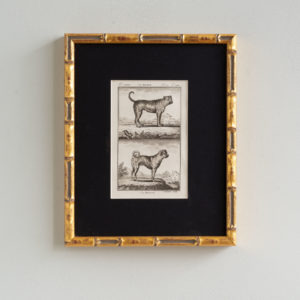
18th Century French Engravings of Dogs
£175 each18th Century French Engravings of Dogs
Published for, Histoire naturelle, générale et particulière (1749–1804), which was the first modern attempt to systematically present all existing knowledge in the fields of natural history, geology, and anthropology.£175 each -
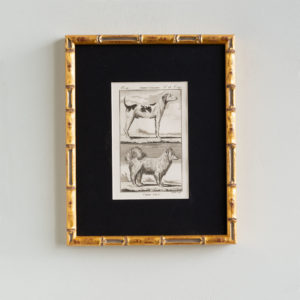
18th Century French Engravings of Dogs
£175 each18th Century French Engravings of Dogs
Published for, Histoire naturelle, générale et particulière (1749–1804), which was the first modern attempt to systematically present all existing knowledge in the fields of natural history, geology, and anthropology.£175 each -
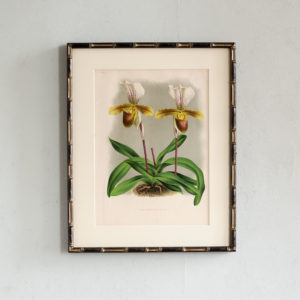
Linden Botanicals
£175 eachLinden Botanicals
L’Illustration Horticole, was a monthly horticultural review, founded in 1854 in Ghent, Belgium, by Ambroise Verschaffelt, a nurseryman who specialised in new plant introductions from South America. The lavish illustrations were produced by some of the very best botanical artists and lithographers – A. Goosens, P. De Pannemaeker and J. Goffart. The L’Illustration Horticole although founded by Jean Jules Linden (1817 – 1898) became a collaborative effort of many great horticulturists and field botanists of the day. Jean Linden in his own right was a renowned orchid grower and collector. Each monthly edition featured chromolithograph of botanical prints. Plants such as orchids, camellias, roses and leafy plants such as ferns and palm trees were represented. The magazine’s scope included pictures, descriptions, the history and culture of “the most remarkable plants,” new introductions, horticultural history, botanical expeditions, and accounts of the major expositions and of new works on botany and horticulture as well as garden descriptions and layouts.£175 each -
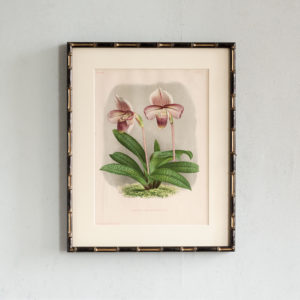
Linden Botanicals
£175 eachLinden Botanicals
L’Illustration Horticole, was a monthly horticultural review, founded in 1854 in Ghent, Belgium, by Ambroise Verschaffelt, a nurseryman who specialised in new plant introductions from South America. The lavish illustrations were produced by some of the very best botanical artists and lithographers – A. Goosens, P. De Pannemaeker and J. Goffart. The L’Illustration Horticole although founded by Jean Jules Linden (1817 – 1898) became a collaborative effort of many great horticulturists and field botanists of the day. Jean Linden in his own right was a renowned orchid grower and collector. Each monthly edition featured chromolithograph of botanical prints. Plants such as orchids, camellias, roses and leafy plants such as ferns and palm trees were represented. The magazine’s scope included pictures, descriptions, the history and culture of “the most remarkable plants,” new introductions, horticultural history, botanical expeditions, and accounts of the major expositions and of new works on botany and horticulture as well as garden descriptions and layouts.£175 each -
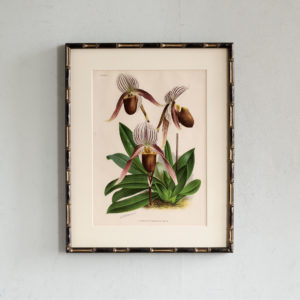
Linden Botanicals
£175 eachLinden Botanicals
L’Illustration Horticole, was a monthly horticultural review, founded in 1854 in Ghent, Belgium, by Ambroise Verschaffelt, a nurseryman who specialised in new plant introductions from South America. The lavish illustrations were produced by some of the very best botanical artists and lithographers – A. Goosens, P. De Pannemaeker and J. Goffart. The L’Illustration Horticole although founded by Jean Jules Linden (1817 – 1898) became a collaborative effort of many great horticulturists and field botanists of the day. Jean Linden in his own right was a renowned orchid grower and collector. Each monthly edition featured chromolithograph of botanical prints. Plants such as orchids, camellias, roses and leafy plants such as ferns and palm trees were represented. The magazine’s scope included pictures, descriptions, the history and culture of “the most remarkable plants,” new introductions, horticultural history, botanical expeditions, and accounts of the major expositions and of new works on botany and horticulture as well as garden descriptions and layouts.£175 each -

Chess,
£175Chess,
Framed chromolithograph by APE (Carlo Pellegrini) picturing Joseph Henry Blackburne, British chess master nicknamed 'The Black Death'. Despite only taking up the game at the age of 17 Blackburn became a world champion many times over and an icon of 'Romantic Chess'.£175 -
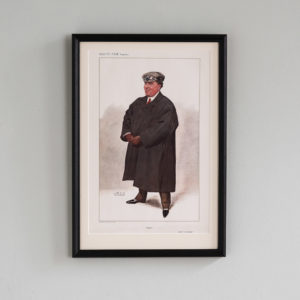
Steam
£175Steam
A framed chromolithograph by SPY (Leslie Ward) depicting Frederic Abernethy Coleman, writer, journalist, military historian & motoring pioneer. He popularised the White Steam Car in England and was a fierce opponent of the 'petrol car brigade' preferring and championing steam powered motorcars. Steam powered cars had the ascendancy in early British motoring, particularly in hill-climbs until they were banned from competition by advocates of the petrol engine,£175 -
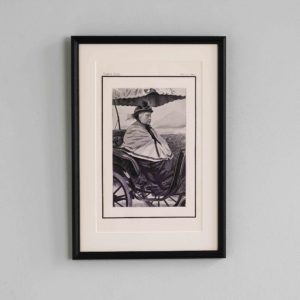
Her Majesty the Queen Empress,
£170 -
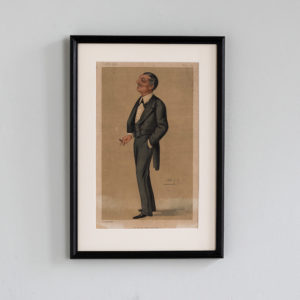
In His Military Capacity,
£170In His Military Capacity,
Framed Chromolithograph by SPY (Leslie Ward) depicting Mr Montagu Williams QC, teacher, British Army officer, actor, playwright, barrister and magistrate. His succesful defence of Mr John Young in his manslaughter trial, after the death of an opponent in the boxing ring, established a legal precedent around the sport.£170 -
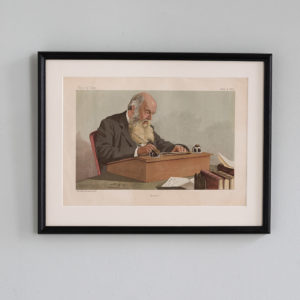
Balliol,
£170Balliol,
Framed Chromolithograph by Spy (Leslie Ward) depicting Edward Caird FRSA FBA. Scottish philosopher on the latter part of the 19th century, Caird is considered one of the fathers of the British Idealist school, a philosophical movement that was influential in Britain from the mid-nineteenth century until its overthrow by the Analytic Philosophy associated with Bertrand Russell. He served as Master of Balliol college until 1907.£170 -

First Violin,
£170First Violin,
Framed Chromolithograph by Spy (Leslie Ward) picturing HRH The Duke of Edinburgh, Alfred Ernest Albert, later Duke of Saxe Coburg and Gotha. The second son of Victoria and Albert he joined the Royal Navy at 14, he rose through the ranks to attain the position of Admiral of the Fleet by 1893 having served as Cadet, Lieutenant and Captain of HMS Galatea which he commanded in the Pacific Ocean. He commanded both the Channel fleet and, later, the Mediterranean Fleet from his flagship HMS Alexandra. The Duke survived an assassination attempt while visiting Sydney Australia and went on to marry a Grand Duchess of Russia. Alfred was a musical enthusiast and took a leading role in the establishment of the the Royal College of Music in 1882. He was a particularly keen violinist although his playing was not of the first quality. After a dinner party given by one of his brothers where he was persuaded to play Sir Henry Ponsonby would write: 'Fiddle out of tune and noise abominable'£170 -

Eduard Strauss,
£170Eduard Strauss,
Framed Chromolithograph signed EBN depicting the Austrian composer and conductor Eduard Strauss, brother of Johann II and Josef Strauss.£170 -
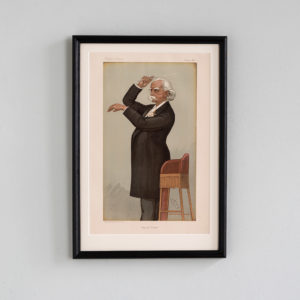
Crystal Palace,
£170Crystal Palace,
Framed Chromolithograph by Spy (Leslie Ward) picturing Sir August Friedrich Manns, German born British Composer and a key figure in the musical life of the Crystal Palace where he conducted a 90 piece orchestra.£170 -
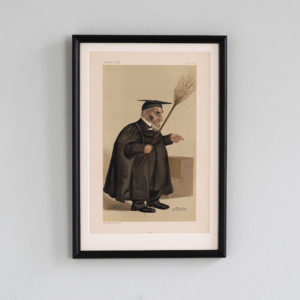
Jimmy,
£170Jimmy,
Framed chromolithograph picturing the Revd. James Leigh Jones, English clergyman and schoolmaster at Eton College. Teacher of Swinburne and the Duke of Argyll. Famed for his application of the birching rod and his regular flogging of his pupils.£170 -
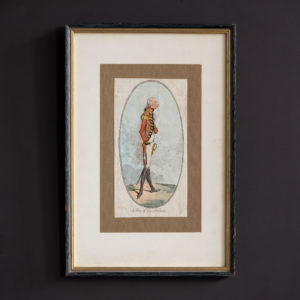
William Frederick, 2nd Duke of Gloucester (‘A slice of Glo’ster cheese’) by James Gillray
£160William Frederick, 2nd Duke of Gloucester (‘A slice of Glo’ster cheese’) by James Gillray
A whole length hand-coloured Georgian caricature-portrait of Prince William Frederick of Gloucester. Designed in an oval setting, the Prince is shown in profile, facing rightwards, and bearing a strong and suggestive resemblance to his uncle King George III. He is shown wearing military uniform, having served in Flanders in 1794 during the Revolutionary Wars. The Prince, later the Duke, of Gloucester had become popularly and affectionately known as 'Slice of Gloster' or simply 'Slice' by the early 1700s.£160 -
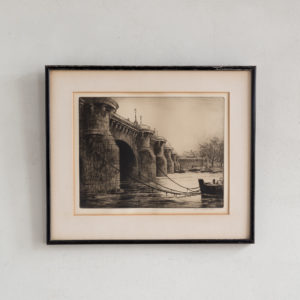
Pont Neuf, Paris, by Herbert Hillier
£160 -
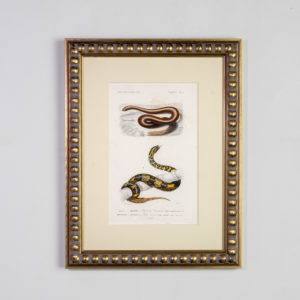
Snakes engravings published c1860
£160 eachSnakes engravings published c1860
Charles Henry Dessalines d'Orbigny was a French botanist and geologist specializing in the Tertiary of France. He was the younger brother of French naturalist and South American explorer, Alcide d'Orbigny. At the National Museum of Natural History in Paris, d'Orbigny identified many of the flowering plant species returned to France from his brother's natural history collecting journeys through South America.£160 each -
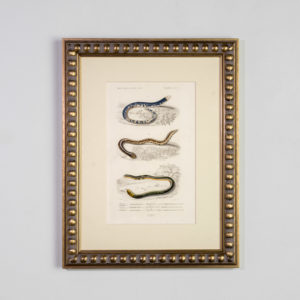
Snakes engravings published c1860
£160 eachSnakes engravings published c1860
Charles Henry Dessalines d'Orbigny was a French botanist and geologist specializing in the Tertiary of France. He was the younger brother of French naturalist and South American explorer, Alcide d'Orbigny. At the National Museum of Natural History in Paris, d'Orbigny identified many of the flowering plant species returned to France from his brother's natural history collecting journeys through South America.£160 each -

Snakes engravings published c1860
£160 eachSnakes engravings published c1860
Charles Henry Dessalines d'Orbigny was a French botanist and geologist specializing in the Tertiary of France. He was the younger brother of French naturalist and South American explorer, Alcide d'Orbigny. At the National Museum of Natural History in Paris, d'Orbigny identified many of the flowering plant species returned to France from his brother's natural history collecting journeys through South America.£160 each -
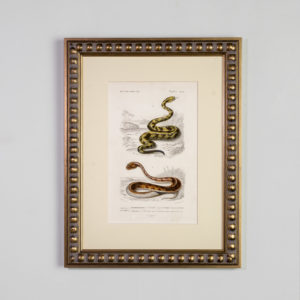
Snakes engravings published c1860
£160 eachSnakes engravings published c1860
Charles Henry Dessalines d'Orbigny was a French botanist and geologist specializing in the Tertiary of France. He was the younger brother of French naturalist and South American explorer, Alcide d'Orbigny. At the National Museum of Natural History in Paris, d'Orbigny identified many of the flowering plant species returned to France from his brother's natural history collecting journeys through South America.£160 each -
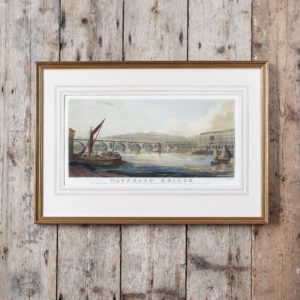
Waterloo Bridge,
£150Waterloo Bridge,
Hand colured and engraved, framed and mounted print depicting John Rennie's Waterloo Bridge by the artist and engraver John Shury after a painting by W.G. Moss.£150 -
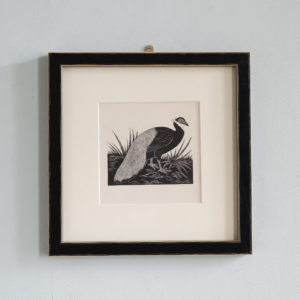
Woodcuts by Eric Fitch Dalglish,
£150 eachWoodcuts by Eric Fitch Dalglish,
Eric Fitch Dalglish was a wood-engraver, painter, draughtsman, author, illustrator and naturalist. Born in London, he studied at university both in London and Bonn, Germany and after WWI was taught engraving by Paul Nash. He exhibited at the Redfern Gallery, with the Society of Wood Engravers, of which he was a member, and the New English Art Club. Examples of his work are held by the British Museum, V&A Museum, Manchester City Art Gallery, and British Council Collection.£150 each -

Woodcuts by Eric Fitch Dalglish,
£150 eachWoodcuts by Eric Fitch Dalglish,
Eric Fitch Dalglish was a wood-engraver, painter, draughtsman, author, illustrator and naturalist. Born in London, he studied at university both in London and Bonn, Germany and after WWI was taught engraving by Paul Nash. He exhibited at the Redfern Gallery, with the Society of Wood Engravers, of which he was a member, and the New English Art Club. Examples of his work are held by the British Museum, V&A Museum, Manchester City Art Gallery, and British Council Collection.£150 each -
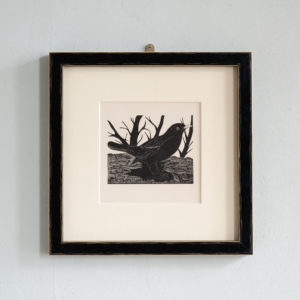
Woodcuts by Eric Fitch Dalglish,
£150 eachWoodcuts by Eric Fitch Dalglish,
Eric Fitch Dalglish was a wood-engraver, painter, draughtsman, author, illustrator and naturalist. Born in London, he studied at university both in London and Bonn, Germany and after WWI was taught engraving by Paul Nash. He exhibited at the Redfern Gallery, with the Society of Wood Engravers, of which he was a member, and the New English Art Club. Examples of his work are held by the British Museum, V&A Museum, Manchester City Art Gallery, and British Council Collection.£150 each -
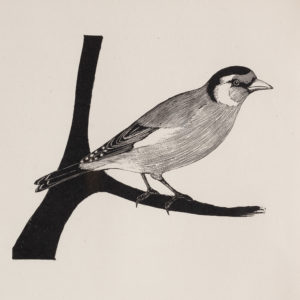
Woodcuts by Eric Fitch Dalglish,
£150 eachWoodcuts by Eric Fitch Dalglish,
Eric Fitch Dalglish was a wood-engraver, painter, draughtsman, author, illustrator and naturalist. Born in London, he studied at university both in London and Bonn, Germany and after WWI was taught engraving by Paul Nash. He exhibited at the Redfern Gallery, with the Society of Wood Engravers, of which he was a member, and the New English Art Club. Examples of his work are held by the British Museum, V&A Museum, Manchester City Art Gallery, and British Council Collection.£150 each -
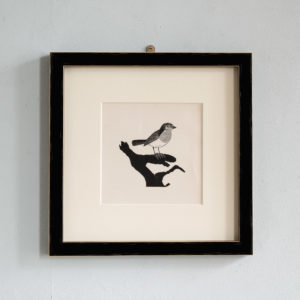
Woodcuts by Eric Fitch Dalglish,
£150 eachWoodcuts by Eric Fitch Dalglish,
Eric Fitch Dalglish was a wood-engraver, painter, draughtsman, author, illustrator and naturalist. Born in London, he studied at university both in London and Bonn, Germany and after WWI was taught engraving by Paul Nash. He exhibited at the Redfern Gallery, with the Society of Wood Engravers, of which he was a member, and the New English Art Club. Examples of his work are held by the British Museum, V&A Museum, Manchester City Art Gallery, and British Council Collection.£150 each -
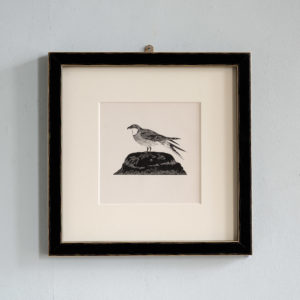
Woodcuts by Eric Fitch Dalglish,
£150 eachWoodcuts by Eric Fitch Dalglish,
Eric Fitch Dalglish was a wood-engraver, painter, draughtsman, author, illustrator and naturalist. Born in London, he studied at university both in London and Bonn, Germany and after WWI was taught engraving by Paul Nash. He exhibited at the Redfern Gallery, with the Society of Wood Engravers, of which he was a member, and the New English Art Club. Examples of his work are held by the British Museum, V&A Museum, Manchester City Art Gallery, and British Council Collection.£150 each -
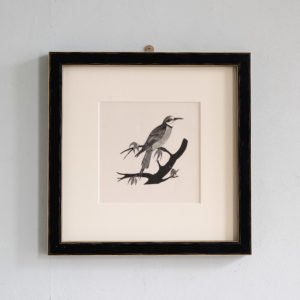
Woodcuts by Eric Fitch Dalglish,
£150 eachWoodcuts by Eric Fitch Dalglish,
Eric Fitch Dalglish was a wood-engraver, painter, draughtsman, author, illustrator and naturalist. Born in London, he studied at university both in London and Bonn, Germany and after WWI was taught engraving by Paul Nash. He exhibited at the Redfern Gallery, with the Society of Wood Engravers, of which he was a member, and the New English Art Club. Examples of his work are held by the British Museum, V&A Museum, Manchester City Art Gallery, and British Council Collection.£150 each -
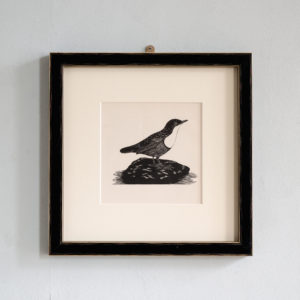
Woodcuts by Eric Fitch Dalglish,
£150 eachWoodcuts by Eric Fitch Dalglish,
Eric Fitch Dalglish was a wood-engraver, painter, draughtsman, author, illustrator and naturalist. Born in London, he studied at university both in London and Bonn, Germany and after WWI was taught engraving by Paul Nash. He exhibited at the Redfern Gallery, with the Society of Wood Engravers, of which he was a member, and the New English Art Club. Examples of his work are held by the British Museum, V&A Museum, Manchester City Art Gallery, and British Council Collection.£150 each -
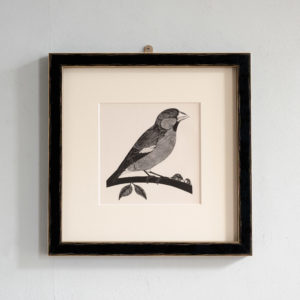
Woodcuts by Eric Fitch Dalglish,
£150 eachWoodcuts by Eric Fitch Dalglish,
Eric Fitch Dalglish was a wood-engraver, painter, draughtsman, author, illustrator and naturalist. Born in London, he studied at university both in London and Bonn, Germany and after WWI was taught engraving by Paul Nash. He exhibited at the Redfern Gallery, with the Society of Wood Engravers, of which he was a member, and the New English Art Club. Examples of his work are held by the British Museum, V&A Museum, Manchester City Art Gallery, and British Council Collection.£150 each -
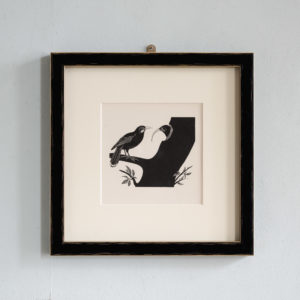
Woodcuts by Eric Fitch Dalglish,
£150 eachWoodcuts by Eric Fitch Dalglish,
Eric Fitch Dalglish was a wood-engraver, painter, draughtsman, author, illustrator and naturalist. Born in London, he studied at university both in London and Bonn, Germany and after WWI was taught engraving by Paul Nash. He exhibited at the Redfern Gallery, with the Society of Wood Engravers, of which he was a member, and the New English Art Club. Examples of his work are held by the British Museum, V&A Museum, Manchester City Art Gallery, and British Council Collection.£150 each -
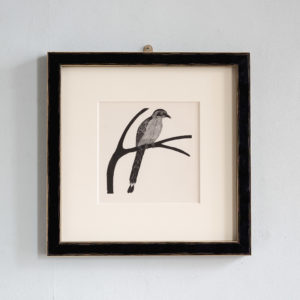
Woodcuts by Eric Fitch Dalglish
£150 eachWoodcuts by Eric Fitch Dalglish
Eric Fitch Dalglish was a wood-engraver, painter, draughtsman, author, illustrator and naturalist. Born in London, he studied at university both in London and Bonn, Germany and after WWI was taught engraving by Paul Nash. He exhibited at the Redfern Gallery, with the Society of Wood Engravers, of which he was a member, and the New English Art Club. Examples of his work are held by the British Museum, V&A Museum, Manchester City Art Gallery, and British Council Collection.£150 each -
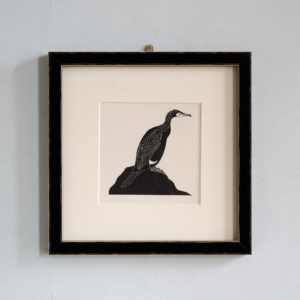
Woodcuts by Eric Fitch Dalglish
£150 eachWoodcuts by Eric Fitch Dalglish
Eric Fitch Dalglish was a wood-engraver, painter, draughtsman, author, illustrator and naturalist. Born in London, he studied at university both in London and Bonn, Germany and after WWI was taught engraving by Paul Nash. He exhibited at the Redfern Gallery, with the Society of Wood Engravers, of which he was a member, and the New English Art Club. Examples of his work are held by the British Museum, V&A Museum, Manchester City Art Gallery, and British Council Collection.£150 each -
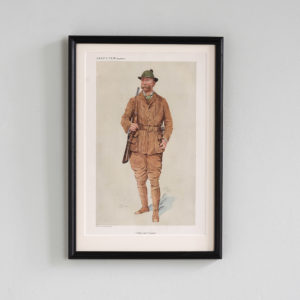
Tracks and Triggers,
£150Tracks and Triggers,
A Framed chromolithograph by WHO picturing Mr Walter Winans, American marksman, hunter and artist. Author The Art of Revolver Shooting, Winans owned hunting and shooting rights to 250,000 acres in the Scottish Highlands across Glen Strathfarrar, Glen Cannich and Glen Affric. In 1884 he attempted to prosecute a Scotsman, Muirdoch Macrae, for grazing a lamb on the ancestral lands of Clan McCrae but owned in law by Winans. The failure of Winans' prosecution established the right to roam which was a key element in opening British parklands to the public.£150 -
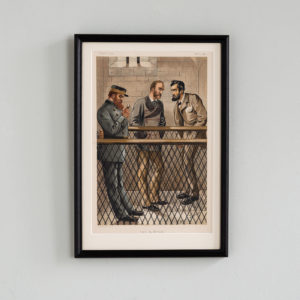
Force No Remedy
£150Force No Remedy
A framed chromolithograph by Harry Furniss picturing a prison warder, Charles Stewart Parnell and John Dillon pictured on remand in Kilmainham Gaol, Dublin. Parnell and Dillon were united in opposition to the Irish Land Act of 1881 which aimed to resolve landlord tenant relations in late 19th Century Ireland and neutralise the militancy of the Irish Land League. Accused of "sabotaging the Land Act", the pair were arrested on the 12th of October 1881 for their role in the declaration and propagation of the No Rent Manifesto, a radical proposal by the Land League calling for a campaign of passive resistance by the small tenant farmers of Ireland and the withholding of rent to landlords.£150 -
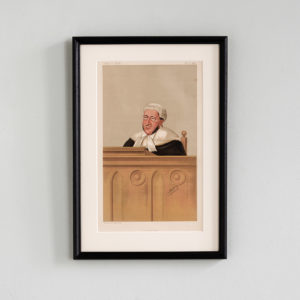
The New Judge
£150The New Judge
A framed chromolithograph by SPY (Sir Leslie Ward) picturing the Hon. Sir Arthur Charles who presided over the first trial of Oscar Wilde for sodomy and gross indecency in which the Jury failed to agree a verdict.£150 -
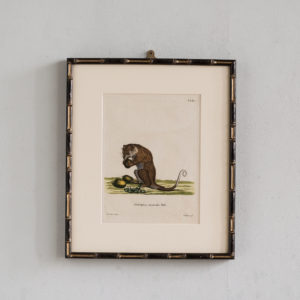
De Buffon, 18th Century natural history,
£150 eachDe Buffon, 18th Century natural history,
Animal prints, based on he work of Georges-Louis Leclerc, count de Buffon, who attempted to systematically present all existing knowledge in the fields of natural history, geology, and anthropology in a single publication. Published c1740, Latin and German text. Presented in faux bamboo frames. 'Didelphys Orientalis Pall.'£150 each -
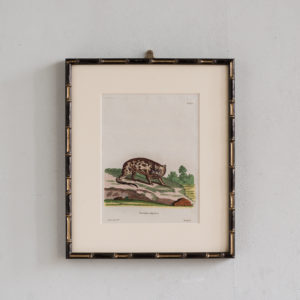
De Buffon, 18th Century natural history,
£150 eachDe Buffon, 18th Century natural history,
Animal prints, based on he work of Georges-Louis Leclerc, count de Buffon, who attempted to systematically present all existing knowledge in the fields of natural history, geology, and anthropology in a single publication. Published c1740, Latin and German text. Presented in faux bamboo frames. 'Viverra tigrina'.£150 each -
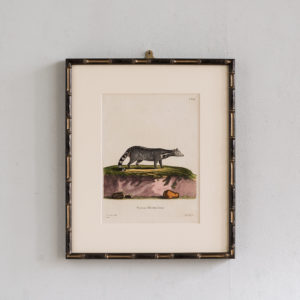
De Buffon, 18th Century natural history,
£150 eachDe Buffon, 18th Century natural history,
Animal prints, based on he work of Georges-Louis Leclerc, count de Buffon, who attempted to systematically present all existing knowledge in the fields of natural history, geology, and anthropology in a single publication. Published c1740, Latin and German text. Presented in faux bamboo frames. 'Viverra Zibetha Linn'.£150 each -
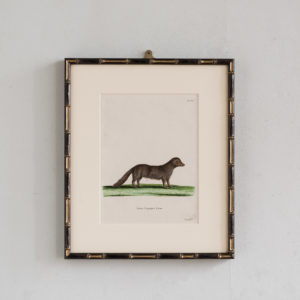
De Buffon, 18th Century natural history,
£150 eachDe Buffon, 18th Century natural history,
Animal prints, based on he work of Georges-Louis Leclerc, count de Buffon, who attempted to systematically present all existing knowledge in the fields of natural history, geology, and anthropology in a single publication. Published c1740, Latin and German text. Presented in faux bamboo frames. 'Canis Lagopus Linn.'.£150 each -
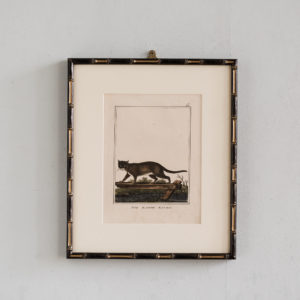
De Buffon, 18th Century natural history,
£150 eachDe Buffon, 18th Century natural history,
Animal prints, based on he work of Georges-Louis Leclerc, count de Buffon, who attempted to systematically present all existing knowledge in the fields of natural history, geology, and anthropology in a single publication. Published c1740, Latin and German text. Presented in faux bamboo frames. 'Die Zahme Katze'.£150 each -
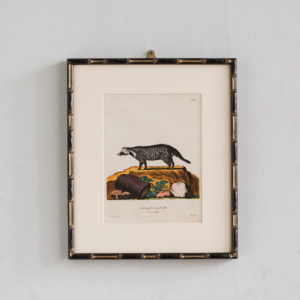
De Buffon, 18th Century natural history,
£150 eachDe Buffon, 18th Century natural history,
Animal prints, based on he work of Georges-Louis Leclerc, count de Buffon, who attempted to systematically present all existing knowledge in the fields of natural history, geology, and anthropology in a single publication. Published c1740, Latin and German text. Presented in faux bamboo frames. 'Viverra Civetta Buff.'.£150 each -
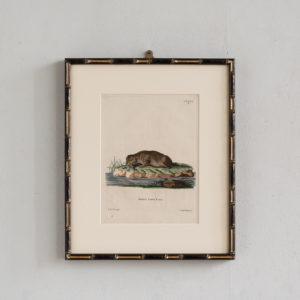
De Buffon, 18th Century natural history,
£150 eachDe Buffon, 18th Century natural history,
Animal prints, based on he work of Georges-Louis Leclerc, count de Buffon, who attempted to systematically present all existing knowledge in the fields of natural history, geology, and anthropology in a single publication. Published c1740, Latin and German text. Presented in faux bamboo frames. 'Mustela Lutra Linn.'.£150 each -
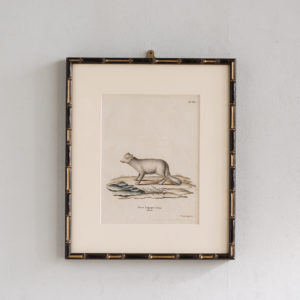
De Buffon, 18th Century natural history,
£150 eachDe Buffon, 18th Century natural history,
Animal prints, based on he work of Georges-Louis Leclerc, count de Buffon, who attempted to systematically present all existing knowledge in the fields of natural history, geology, and anthropology in a single publication. Published c1740, Latin and German text. Presented in faux bamboo frames. 'Canis Lagopus Linn.'.£150 each -

De Buffon, 18th Century natural history,
£150 eachDe Buffon, 18th Century natural history,
Animal prints, based on he work of Georges-Louis Leclerc, count de Buffon, who attempted to systematically present all existing knowledge in the fields of natural history, geology, and anthropology in a single publication. Published c1740, Latin and German text. Presented in faux bamboo frames. 'Der Ziegenbock.£150 each -
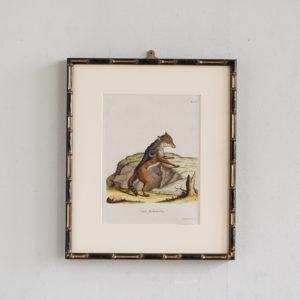
De Buffon, 18th Century natural history,
£150 eachDe Buffon, 18th Century natural history,
Animal prints, based on he work of Georges-Louis Leclerc, count de Buffon, who attempted to systematically present all existing knowledge in the fields of natural history, geology, and anthropology in a single publication. Published c1740, Latin and German text. Presented in faux bamboo frames. 'Canis Mesomelas.'.£150 each -
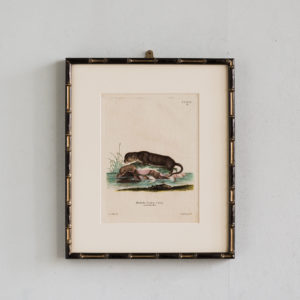
De Buffon, 18th Century natural history,
£150 eachDe Buffon, 18th Century natural history,
Animal prints, based on he work of Georges-Louis Leclerc, count de Buffon, who attempted to systematically present all existing knowledge in the fields of natural history, geology, and anthropology in a single publication. Published c1740, Latin and German text. Presented in faux bamboo frames. 'Mustela Lutra Linn. canadensis'.£150 each -
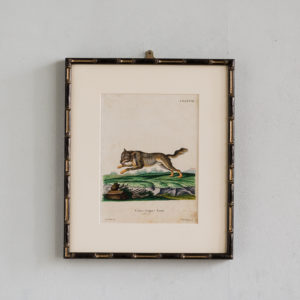
De Buffon, 18th Century natural history,
£150 eachDe Buffon, 18th Century natural history,
Animal prints, based on he work of Georges-Louis Leclerc, count de Buffon, who attempted to systematically present all existing knowledge in the fields of natural history, geology, and anthropology in a single publication. Published c1740, Latin and German text. Presented in faux bamboo frames. 'Canis Lupus Linn.'.£150 each -
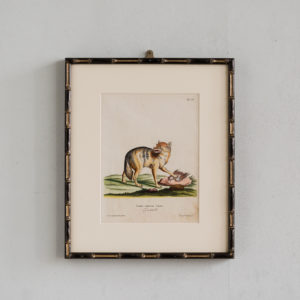
De Buffon, 18th Century natural history,
£150 eachDe Buffon, 18th Century natural history,
Animal prints, based on he work of Georges-Louis Leclerc, count de Buffon, who attempted to systematically present all existing knowledge in the fields of natural history, geology, and anthropology in a single publication. Published c1740, Latin and German text. Presented in faux bamboo frames. 'Canis aureus Linn'.£150 each
Featured Items
-
No records found

